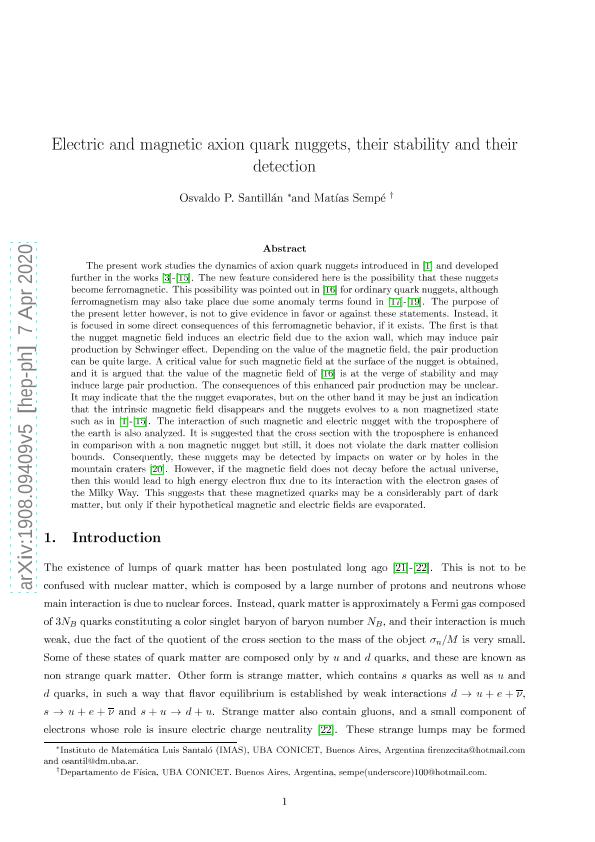Mostrar el registro sencillo del ítem
dc.contributor.author
Santillán, Osvaldo Pablo

dc.contributor.author
Sempe, Matias Nicolas

dc.date.available
2021-08-25T15:35:26Z
dc.date.issued
2020-05
dc.identifier.citation
Santillán, Osvaldo Pablo; Sempe, Matias Nicolas; Electric and magnetic axion quark nuggets, their stability and their detection; Springer; European Physical Journal C: Particles and Fields; 80; 5; 5-2020; 1-29
dc.identifier.issn
1434-6044
dc.identifier.uri
http://hdl.handle.net/11336/138903
dc.description.abstract
The present work studies the dynamics of axion quark nuggets introduced in Zhitnitsky (JCAP 0310:010, 2003) and developed further in the works (Zhitnitsky in Phys Rev D 74:043515, 2006; Lawson and Zhitnitsky in Phys Lett B 724, 17, 2013; Lawson and Zhitnitsky in Phys Rev D 95:063521, 2017; Liang and Zhitnitsky in Phys Rev D 94:083502, 2016; Ge et al. in Phys Rev D 97:043008, 2018; Zhitnitsky in Phys Dark Univ 22:1, 2018; Lawson and Zhitnitsky in Phys Dark Univ 100295, 2019; Raza et al. in Phys Rev D 98:103527, 2018; Fischer et al. in Phys Rev D 98:043013, 2018; van Waerbeke and Zhitnitsky in Phys Rev D 99:043535, 2019; Flambaum and Zhitnitsky in Phys Rev D 99:043535, 2019; Lawson and Zhitnitsky in JCAP 02:049, 2017; Ge et al. in Phys Rev D 99:116017, 2019). The new feature considered here is the possibility that these nuggets become ferromagnetic. This possibility was pointed out in Tatsumi (Phys Lett B 489:280 2000) for ordinary quark nuggets, although ferromagnetism may also take place due some anomaly terms found in Son and Zhitnitsky (Phys Rev D 70:074018, 2004), Son and Stephanov (Phys Rev D 77:014021, 2008) and Melitski and Zhitnitsky (Phys Rev D 72:045011, 2005). The purpose of the present letter however, is not to give evidence in favor or against these statements. Instead, it is focused in some direct consequences of this ferromagnetic behavior, if it exists. The first is that the nugget magnetic field induces an electric field due to the axion wall, which may induce pair production by Schwinger effect. Depending on the value of the magnetic field, the pair production can be quite large. A critical value for such magnetic field at the surface of the nugget is obtained, and it is argued that the value of the magnetic field of Tatsumi (2000) is at the verge of stability and may induce large pair production. The consequences of this enhanced pair production may be unclear. It may indicate that the the nugget evaporates, but on the other hand it may be just an indication that the intrinsic magnetic field disappears and the nuggets evolves to a non magnetized state such as in Zhitnitsky (2003), Oaknin and Zhitnitsky (Phys. Rev. D 71:023519, 2005), Zhitnitsky (2006), Lawson and Zhitnitsky (2013), Lawson and Zhitnitsky (2017), Liang and Zhitnitsky (2016), Ge et al. (2018), Zhitnitsky (2018), Lawson and Zhitnitsky (2019), Raza et al. (2018), Fischer et al. (2018), van Waerbeke and Zhitnitsky (2019), Flambaum and Zhitnitsky (2019), Lawson and Zhitnitsky (2017), and Ge et al. (2019). The interaction of such magnetic and electric nugget with the troposphere of the earth is also analyzed. It is suggested that the cross section with the troposphere is enhanced in comparison with a non magnetic nugget but still, it does not violate the dark matter collision bounds. Consequently, these nuggets may be detected by impacts on water or by holes in the mountain craters (Pace VanDevender et al. in Sci Rep 7:8758, 2017). However, if the magnetic field does not decay before the actual universe, then this would lead to high energy electron flux due to its interaction with the electron gases of the Milky Way. This suggests that these magnetized quarks may be a considerably part of dark matter, but only if their hypothetical magnetic and electric fields are evaporated.
dc.format
application/pdf
dc.language.iso
eng
dc.publisher
Springer

dc.rights
info:eu-repo/semantics/openAccess
dc.rights.uri
https://creativecommons.org/licenses/by-nc-sa/2.5/ar/
dc.subject
AXIONS
dc.subject
TOPOLOGICAL
dc.subject
DEFECTS
dc.subject
SCHWINGER
dc.subject.classification
Otras Ciencias Físicas

dc.subject.classification
Ciencias Físicas

dc.subject.classification
CIENCIAS NATURALES Y EXACTAS

dc.title
Electric and magnetic axion quark nuggets, their stability and their detection
dc.type
info:eu-repo/semantics/article
dc.type
info:ar-repo/semantics/artículo
dc.type
info:eu-repo/semantics/publishedVersion
dc.date.updated
2021-07-30T18:55:37Z
dc.journal.volume
80
dc.journal.number
5
dc.journal.pagination
1-29
dc.journal.pais
Alemania

dc.journal.ciudad
Berlin
dc.description.fil
Fil: Santillán, Osvaldo Pablo. Consejo Nacional de Investigaciones Científicas y Técnicas. Centro Científico Tecnológico Conicet - San Luis. Instituto de Matemática Aplicada de San Luis "Prof. Ezio Marchi". Universidad Nacional de San Luis. Facultad de Ciencias Físico, Matemáticas y Naturales. Instituto de Matemática Aplicada de San Luis "Prof. Ezio Marchi"; Argentina
dc.description.fil
Fil: Sempe, Matias Nicolas. Consejo Nacional de Investigaciones Científicas y Técnicas; Argentina
dc.journal.title
European Physical Journal C: Particles and Fields

dc.relation.alternativeid
info:eu-repo/semantics/altIdentifier/url/https://link.springer.com/article/10.1140%2Fepjc%2Fs10052-020-8027-2
dc.relation.alternativeid
info:eu-repo/semantics/altIdentifier/doi/https://doi.org/10.1140/epjc/s10052-020-8027-2
dc.relation.alternativeid
info:eu-repo/semantics/altIdentifier/arxiv/https://arxiv.org/abs/1908.09409
Archivos asociados
